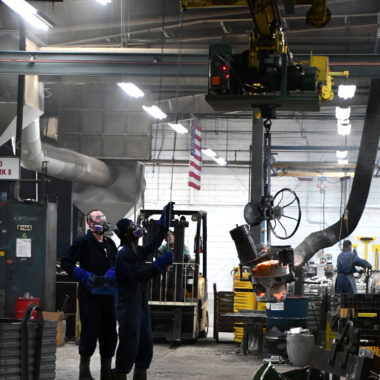The Ultimate Guide to Aluminum Casting: Professional Insights and Finest Practices
The Ultimate Guide to Aluminum Casting: Professional Insights and Finest Practices
Blog Article
The Leading Methods for Light Weight Aluminum Spreading That You Need to Know
From the traditional sand spreading approach to the complex investment casting process, each strategy supplies special advantages that cater to different project needs. As we browse with the top techniques for light weight aluminum spreading, it ends up being apparent that mastering these approaches is critical for accomplishing ideal results.
Sand Spreading Method
The Sand Casting Strategy is an essential method in light weight aluminum casting, widely made use of for its cost-effectiveness and adaptability in creating detailed metal shapes. This method involves developing a mold made of compressed sand right into which liquified aluminum is put, allowing it to strengthen and take the shape of the mold and mildew. One of the vital advantages of sand spreading is its capability to generate complicated geometries with relatively low tooling prices, making it an appealing option for makers looking to produce unique elements.
In the sand spreading procedure, a pattern of the last component is pushed right into a great sand mixture included within a flask. Sand casting is typically utilized in different sectors, consisting of auto, aerospace, and art shops, due to its ability to produce both large and small metal parts with detailed styles.

Financial Investment Casting Process
An intricate technique employed in light weight aluminum casting is the Financial investment Casting Process, understood for its ability to generate highly described and elaborate steel components. Referred to as the lost-wax casting procedure, this strategy dates back thousands of years and remains a prominent choice in various markets due to its convenience and precision.
The financial investment spreading process begins with the development of a wax pattern, which is covered with a ceramic shell to form a mold and mildew. The wax is after that melted out, leaving a tooth cavity in the form of the wanted component. Molten aluminum is poured right into the ceramic mold and mildew, filling the cavity and taking on the intricate details of the original wax pattern.
This technique is preferred for its capacity to produce complex shapes with exceptional surface area coating and dimensional precision. It is commonly used in the production of aerospace elements, fashion jewelry, and commercial equipment where detailed layouts are called for. The financial investment casting process offers high repeatability and can produce parts with minimal machining required, making it an economical option for lots of applications.
Irreversible Mold And Mildew Technique
Using a various method from the Investment Casting Refine, the Permanent Mold and mildew Method in aluminum spreading uses an unique method for her latest blog producing metal parts. The warm transfer from the molten steel to the mold helps in strengthening the aluminum quickly, lowering the cooling time compared to sand spreading.
One of the key benefits of the Long-term Mold And Mildew Technique is the improved surface area finish and dimensional precision of the castings created. This method is additionally known for its capacity to create high-strength light weight aluminum components with regular quality. In addition, the reusable nature of the mold and mildew makes it an affordable alternative for medium to high quantity production runs.
Die Spreading Technology
Using innovative manufacturing processes, die casting modern technology presents a highly effective approach for generating elaborate aluminum elements. This strategy entails injecting molten aluminum into a steel mold and mildew, called a die, at high stress. The die is specially developed to shape the aluminum right into the preferred kind, causing high accuracy and excellent surface check this site out finish.
Die casting offers several advantages. It enables the production of complicated shapes with thin walls, tight tolerances, and smooth surfaces, making it optimal for applications where looks and accuracy are crucial. Additionally, die spreading makes it possible for quick manufacturing prices, lowering total production time and expenses.

Lost Foam Spreading Technique
Die casting technology's effectiveness and precision in creating light weight aluminum components lead the method for checking out the Lost Foam Casting Approach as a corresponding manufacturing strategy. Lost Foam Casting, likewise known as evaporative pattern spreading, is an approach that utilizes foam patterns to develop complex aluminum components.
One of the crucial advantages of Lost Foam Casting is its capacity to produce intricate styles with elaborate details that may be challenging to accomplish through conventional spreading methods. In addition, this strategy gets rid of the need for cores, minimizes machining operations, and permits tighter resistances. Lost Foam Casting is especially ideal for tiny to medium-sized light weight aluminum components that require high accuracy and detailed geometries. aluminum casting. As industries proceed to require lightweight yet resilient parts, Lost Foam Casting verifies to be a valuable technique in the world of aluminum casting.
Final Thought
In verdict, comprehending the leading methods for aluminum spreading is vital for accomplishing top notch cause the manufacturing process. Sand spreading, investment spreading, irreversible mold, die spreading, and shed foam casting are all efficient approaches for generating aluminum parts with various degrees of intricacy. By understanding these techniques, makers can make certain that their items meet the desired specs and criteria for efficiency and durability.
From the conventional sand spreading method to the elaborate investment spreading procedure, each method uses one-of-a-kind benefits that provide to various project demands.The Sand Casting Method is an essential technique in light weight aluminum spreading, commonly used for its cost-effectiveness and adaptability in developing complex steel forms. Lost Foam Spreading, likewise understood as evaporative pattern casting, is a technique that uses foam patterns to create intricate aluminum components. As markets continue to demand lightweight yet durable components, Lost Foam Spreading confirms to be a beneficial technique in the realm of light weight aluminum spreading.
Sand casting, investment spreading, irreversible mold, die spreading, and check it out shed foam casting are all effective methods for generating light weight aluminum components with different degrees of intricacy.
Report this page